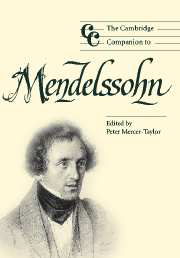Book contents
- Frontmatter
- Introduction: Mendelssohn as border-dweller
- Part I Issues in biography
- Part II Situating the compositions
- Part III Profiles of the music
- 6 Symphony and overture
- 7 The works for solo instrument(s) and orchestra
- 8 Mendelssohn's chamber music
- 9 The music for keyboard
- 10 On Mendelssohn's sacred music, real and imaginary
- 11 Mendelssohn's songs
- 12 Felix Mendelssohn's dramatic compositions: from Liederspiel to Lorelei
- Part IV Reception and performance
- Notes
- Select bibliography
- Index
8 - Mendelssohn's chamber music
from Part III - Profiles of the music
Published online by Cambridge University Press: 28 September 2011
- Frontmatter
- Introduction: Mendelssohn as border-dweller
- Part I Issues in biography
- Part II Situating the compositions
- Part III Profiles of the music
- 6 Symphony and overture
- 7 The works for solo instrument(s) and orchestra
- 8 Mendelssohn's chamber music
- 9 The music for keyboard
- 10 On Mendelssohn's sacred music, real and imaginary
- 11 Mendelssohn's songs
- 12 Felix Mendelssohn's dramatic compositions: from Liederspiel to Lorelei
- Part IV Reception and performance
- Notes
- Select bibliography
- Index
Summary
In the case of a composer like Mendelssohn, it is not easy to claim that a certain part of his oeuvre is more important than another: it was his avowed goal to be active and successful in as many different musical genres as possible, and – with the single exception of opera – he achieved just this. Nevertheless, it can be said that the mature chamber works of Mendelssohn rank not only among the finest works of the composer, but among those achievements of his that were of lasting importance for the entire century. The techniques of motivic combination, derivation, juxtaposition, and interplay that characterize his mature chamber style, which arose from Mendelssohn's fascination with the music of both Johann Sebastian Bach and Ludwig Beethoven, exercised a considerable influence on nineteenth-century instrumental music in general; it is hardly an exaggeration to claim that the technique of “developing variation” has its roots precisely here. Furthermore, their sheer beauty and highly idiomatic writing for all instruments have secured a place in the performance repertoire and the recording market for at least some of these works – particularly the two piano trios and some of the string quartets.
- Type
- Chapter
- Information
- The Cambridge Companion to Mendelssohn , pp. 130 - 148Publisher: Cambridge University PressPrint publication year: 2004

